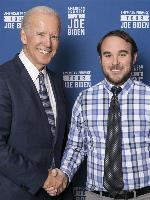

Make Curriculum Accessible to All by Supporting Teachers' Individual Needs |
Participate and share : Poster
Dr. Scott Silver-Bonito Dr. Amy Korn
By providing students choice in learning, student interest will increase, no matter the discipline. This presentation will equip educators with a toolkit of digital activities, alternatives and tools they can use to promote student choice and meet the needs of all students through the principals of Universal Design for Learning.
| Audience: | Coaches, Professional developers, Teachers |
| Skill level: | Beginner |
| Attendee devices: | Devices required |
| Attendee device specification: | Laptop: Chromebook, Mac, PC Tablet: Android, iOS, Windows |
| Participant accounts, software and other materials: | None are necessary but many may be mentioned and suggested. |
| Topic: | Student agency, choice and voice |
| Grade level: | 6-12 |
| Subject area: | STEM/STEAM, World languages |
| ISTE Standards: | For Coaches: Change Agent
Equity and Citizenship Advocate
Designer
|
Teachers and administrators will walk away from this workshop with an understanding of the principles of Universal Design for Learning (UDL) which is a requirement of all teachers under the Every Student Succeeds Act (ESSA) of 2015 and IDEIA. The purpose is to provide teachers with a toolkit of digital resources and tools to meet all students' personalized learning needs in their classroom regardless of the class, subject matter, and/or discipline to meet content standards and measure student mastery and growth. Participants will walk away with an understanding of how UDL can help at the curriculum design phase how to meet all learners needs through the use of multiple means of representation, action & expression, and engagement in units of instruction to support teachers and learners with the implementation and assessment of and for student learning.
1. Definition of Universal Design for Learning
2. Presentation of the Benefits of UDL
a. PD models to support teachers
b. How this supports students and teachers alike
3. Brief Presentation of the Benefits of Digital Learning with UDL.
a. Different learning models including remote, hybrid and in-person learning
b. synchronous and asynchronous learning
4. Presentation and Sharing Tools to Use for UDL and Digital Learning
Universal design for learning (UDL) has been defined as a part of the Every Student Succeeds Act (ESSA) of 2015 as a requirement under law for school districts to implement as part of the inclusion of all students in the general education curriculum (ESSA, 2015).Classrooms in secondary public schools increasingly include a variety of different learners in a traditional setting with a subject area expert teacher to support their curriculum and teach all students. The complexities of students needs have increased because of federal legislation including the Every Student Succeeds Act and Individuals with Disabilities Education Improvement Act (IDEIA) which declare that all students are entitled to the least restrictive learning environment (LRE) which is most often the general education classroom. Thus, teachers of traditional teaching methods need the proper training and supports to meet these changing demands of the learners in their classrooms, particularly those with special education needs. Universal design for learning (UDL) provides a framework for teachers to meet these challenging demands in their classrooms. UDL needs to be properly introduced to teachers in order for them to buy-in to implementing these practices at the secondary level where the focus of learning often becomes about the content and not on each individual student learning the fundamentals. Not all students are able to learn subject area content with the traditional modes of teaching and learning in an inclusive environment. Technology tools are often utilized to meet the variety of needs in any classroom environment to support multiple means of engagement, action & expression, and representation.
Resources.
References
Basham, J. D., Israel, M., Graden, J., Poth, R., & Winston, M. (2010). A comprehensive approach to rti: Embedding universal design for learning and technology. Learning Disability Quarterly, 33(4), 243-255.
Black, D. R., Weinberg, L. A., & Brodwin, M. G. (2015). Universal design for learning and instruction: Perspectives of students with disabilities in higher education. Exceptionality Education International, 25(2), 1-26.
Center For Applied Special Technology. (1998). Universal design for learning.
Coyne, P., Evans, M., & Karger, J. (2017). Use of a UDL literacy environment by middle school students with intellectual and developmental disabilities. Intellectual & Developmental Disabilities, 55(1), 4-14.
Dymond, S. K., Renzaglia, A., Rosenstein, A., Chun, E. J., Banks, R. A., Niswander, V., & Gilson, C. L. (2006). Using a participatory action research approach to create a universally designed inclusive high school science course: A case study. Research and Practice for Persons with Severe Disabilities (RPSD), 31(4), 293-308.
Elder-Hinshaw, R., Manset-Williamson, G., Nelson, J. M., & Dunn, M. W. (2006). Engaging older students with reading disabilities: Multimedia inquiry projects supported by reading assistive technology. TEACHING Exceptional Children, 39(1), 6-11.
Every Student Succeeds Act, 114 U.S.C. § 1177 (2015)
Hall, T. E., Cohen, N., Vue, G., & Ganley, P. (2015). Addressing learning disabilities with UDL and technology: Strategic reader. Learning Disability Quarterly, 38(2), 72-83.
Hitchcock, C. H., Rao, K., Chuan, C. C., & Yuen, J. W. L. (2016). TeenACE for science using multimedia tools and scaffolds to support writing. Rural Special Education Quarterly, 35(2), 10-23.
Hitchcock, C., Meyer, A., Rose, D., & Jackson, R. (2002). Providing new access to the general curriculum. Teaching Exceptional Children, 35(2), 8.
Individuals with Disabilities Education Improvement Act, 20 U.S.C. § 1400 (2004)
International Society for Technology in Education. (2016). ISTE Standards for Students.
Johnson-Harris, K., & Mundschenk, N. A. (2014). Working effectively with students with BD in a general education classroom: The case for universal design for learning. Clearing House: A Journal of Educational Strategies, Issues and Ideas, 87(4), 168-174.
Katz, J. (2015). Implementing the Three Block Model of Universal Design for Learning: effects
on teachers' self-efficacy, stress, and job satisfaction in inclusive classrooms K-
12. International Journal of Inclusive Education, 19(1), 1-20.
Kavanagh Webb, K., & Hoover, J. (2015). Universal design for learning (UDL) in the academic library: A methodology for mapping multiple means of representation in library tutorials. College & Research Libraries, 76(4), 537-553.
Kennedy, M. J., Thomas, C. N., Meyer, J. P., Alves, K. D., & Lloyd, J. W. (2014). Using evidence-based multimedia to improve vocabulary performance of adolescents with LD: A UDL approach. Learning Disability Quarterly, 37(2), 71-86.
King-Sears, M., Johnson, T. M., Berkeley, S., Weiss, M. P., Peters-Burton, E., Evmenova, A. S., Hursh, J. C. (2015). An exploratory study of universal design for teaching chemistry to students with and without disabilities. Learning Disability Quarterly, 38(2), 84-96.
Kortering, L. J., McClannon, T. W., & Braziel, P. M. (2008). Universal design for learning. Remedial and Special Education, 29(6), 352-363.
Lopes-Murphy, S. (2012). Universal design for learning: Preparing secondary education teachers in training to increase academic accessibility of high school English learners. Clearing House, 85(6), 226-230.
Lowrey, K. A., Hollingshead, A., & Howery, K. (2017). A closer look: Examining teachers' language around UDL, inclusive classrooms, and intellectual disability. Intellectual & Developmental Disabilities, 55(1), 15-24.
Marino, M. T., Gotch, C. M., Israel, M., Vasquez,Eleazar, I.,II, Basham, J. D., & Becht, K. (2014). UDL in the middle school science classroom: Can video games and alternative text heighten engagement and learning for students with learning disabilities? Learning Disability Quarterly, 37(2), 87-99.
McGuire, J. M., Scott, S. S., & Shaw, S. F. (2006). Universal design and its applications in educational environments. Remedial and Special Education, 27(3), 166-175.
McMahon, D., Wright, R., Cihak, D., Moore, T., & Lamb, R. (2016). Podcasts on mobile devices as a read-aloud testing accommodation in middle school science assessment. Journal of Science Education & Technology, 25(2), 263-273.
Miller, D. K., & Lang, P. L. (2016). Using the universal design for learning approach in science laboratories to minimize student stress. Journal of Chemical Education, 93(11), 1823-1828.
Parton, B. S. (2017). Glass vision 3D: Digital discovery for the deaf. TechTrends, 61(2), 141-146.
Pearson, M. (2015). Modeling universal design for learning techniques to support multicultural education for pre-service secondary educators. Multicultural Education, 22(3-4), 27-34.
Pisha, B., & Coyne, P. (2001). Smart from the start: The promise of universal design for learning. Remedial and Special Education, 22(4), 197-203.
Ruppar, A. L., Afacan, K., Yang, Y. (., & Pickett, K. J. (2017). Embedded shared reading to increase literacy in an inclusive English/Language arts class: Preliminary efficacy and ecological validity. Education and Training in Autism and Developmental Disabilities, 52(1), 51-63.
Santoyo, C., & Zhang, S. (2016). Secondary teacher candidates' lesson planning learning. Teacher Education Quarterly, 43(2), 3-27.
Scott, L. A., Thoma, C. A., Puglia, L., Temple, P., & D'Aguilar, A. (2017). Implementing a UDL framework: A study of current personnel preparation practices. Intellectual & Developmental Disabilities, 55(1), 25-36.
Spooner, F., Baker, J. N., Harris, A. A., Delzell, L. A., & Browder, D. M. (2007). Effects of training in universal design for learning on lesson plan development. Remedial & Special Education, 28(2), 108-116.
Sokal, L., & Katz, J. (2015). Effects of the Three-Block Model of Universal Design for Learning on Early and Late Middle School Students’ Engagement. Middle Grades Research Journal, 10(2), 65.
Test, D. W., Kemp-Inman, A., Diegelmann, K., Hitt, S. B., & Bethune, L. (2015). Are online sources for identifying evidence-based practices trustworthy? an evaluation. Exceptional Children, 82(1), 58-80.
Woodman, A. C., Smith, L. E., Greenberg, J. S., & Mailick, M. R. (2016). Contextual factors predict patterns of change in functioning over 10 years among adolescents and adults with autism spectrum disorders. Journal of Autism and Developmental Disorders, 46(1), 176-189.
Zelenka, V. (2017). Universal interventions for students with ADHD—and all students. Kappa Delta Pi Record, 53(1), 37-40.

Dr. Scott Silver-Bonito is a middle school educator in World Languages and technology instructional leader for Middlebrook school in Wilton, CT. He will be completing a doctorate in education from Northeastern University in March, 2022. He has studied design thinking's effect on student empathy, problem-solving, and collaboration.

Amy is a passionate educator of 15+ years. Amy was a business education teacher and instructional leader for technology for 11 years before becoming an assistant principal in the same school. Amy wrote and defended her dissertation on supporting math and science teachers with the implementation of Universal Design for Learning. Currently, Amy oversees both the Science and Special Education Departments. Amy is a Google Innovator and Trainer.